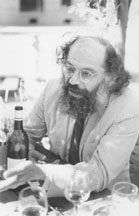
Can't Beat This: Allen Ginsberg enjoys two of his favorites--wine and debate-at downtown Santa Cruz's Cooperhouse in the late '70s.
Photo by Jeff Greenwald
Allen Ginsberg dominates the screen in an epic documentary
By Suzanne Baker
ULTIMATELY A COMING-OF-AGE STORY, The Life and Times of Allen Ginsberg takes an unusually candid and intimate look at the life of the visionary poet. Jerry Aronson spent 10 years compiling the footage for the 82 -minute documentary. In the process, he developed a warm friendship with Ginsberg, and it shows. Aronson's film is a mirror of its subject--as thoughtful, provocative and unassuming as the poet himself. Through a seamlessly blended barrage of black and white stills, home movies, television news footage, various interviews and poetry readings, we watch Ginsberg grow from a pained, bucktoothed boy into an unpretentious literary giant.
Just as Ginsberg's influence has spanned five generations--a testament to his talent and staying power--this film bridges generation gaps. Even those too young to know about the Atomic Disease of the '50s and the Merry Pranksters of the '60s will appreciate and--yes--be moved by Ginsberg's life and times.
And those who do remember life before MTV will be reminded, in grainy black and white stills, of a smooth-faced William Burroughs, a brooding Jack Kerouac and madcap Neal Cassady. Interviews with well-known personalities Timothy Leary, Ken Kesey, Herbert Hunke, Joan Baez, Norman Mailer, Amiri Baraka and Abbie Hoffman give credence to Ginsberg's place among the elite of cultural heroes. Interviews with Ginsberg's father, brother and stepmother round out the man.
Despite the material's bulk, the film moves methodically, giving ample time to Ginsberg's formative childhood years, where his poet father and mentally ill mother transferred to him the cumulative legacy of what Ginsberg calls "poetic paranoia."
At the heart of the documentary lie the Beat and Hippie eras. Under the influence of his "supplementary family"--Burroughs, Kerouac and Cassady--Ginsberg found a niche for his restless creativity and lonely heart. He publicly broke out of his chrysalis with the publication of the legendary Beat anthem Howl.
Thankfully, Aronson finds the time for two partial readings of Howl and a full reading of Kaddish, written in memory of Ginsberg's mother, Naomi. Black and white stills of a woman's mental ward and a photo of Naomi--disoriented, with her arm hung loosely around the young poet--provide a disturbing visual text to the poem.
Footage of police brutality at the 1968 Democratic Convention in Chicago shows a new Ginsberg--a pacifist of quiet courage who calms the volatile crowd with his Buddhist chanting. Aronson was first exposed to Ginsberg at the convention, where he was among those lulled by the poet's amateur "Ohms." Now, almost 30 years later, he provides movie audiences a similar sense of Ginsberg's gentle power.
The Life and Times of Allen Ginsberg, directed by Jerry Aronson, plays on Oct. 9-10 with Robert Frank's Pull My Daisy at the Nickelodeon in downtown Santa Cruz.
[ Metro Santa Cruz | MetroActive Central | Archives ]
![[MetroActive Movies]](/movies/gifs/ma-movies.gif)